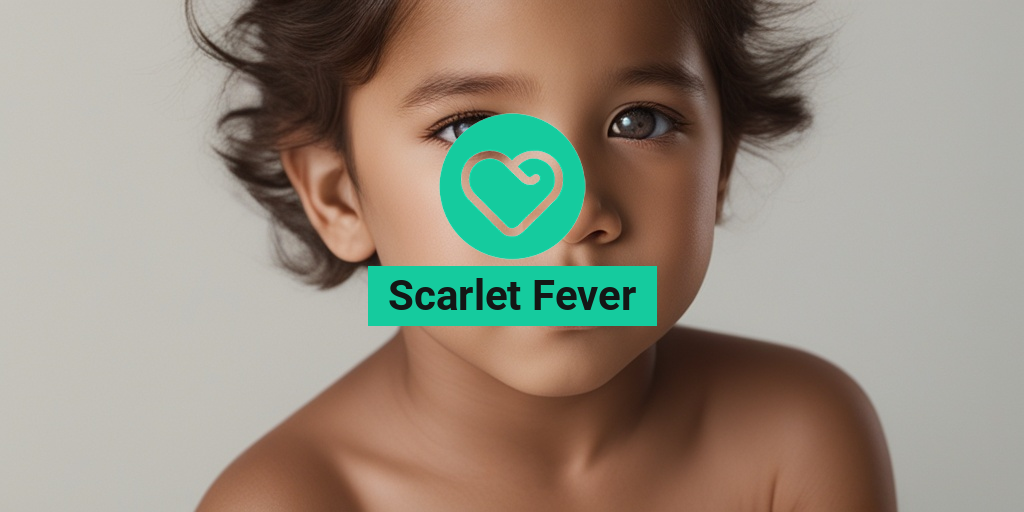What Is Scarlet Fever?
Scarlet fever, also known as scarlatina, is a bacterial infection caused by group A streptococcus (GAS). It’s a contagious disease that typically affects children between the ages of 5 and 15, but can also occur in adults. The infection is usually spread through direct contact with an infected person’s saliva, mucus, or skin lesions.
The bacteria that cause scarlet fever are highly contagious and can be spread through:
- Direct contact with an infected person’s saliva, mucus, or skin lesions
- Indirect contact with contaminated surfaces or objects
- Droplets in the air when an infected person coughs or sneezes
Scarlet fever is often associated with a distinctive red rash, which is where it gets its name. The rash typically appears 12-48 hours after the onset of symptoms and can last for up to two weeks.
Scarlet Fever Symptoms
The symptoms of scarlet fever can vary in severity, but typically include:
Fever
A high fever, usually above 101.5°F (38.6°C), is one of the primary symptoms of scarlet fever. The fever can last for several days and may be accompanied by:
- Chills
- Headache
- General feeling of illness or fatigue
Rash
The characteristic red rash of scarlet fever typically appears 12-48 hours after the onset of symptoms. The rash:
- Feels like sandpaper to the touch
- Appears as a diffuse, bright red, and blanches with pressure
- Usually starts on the neck, chest, and abdomen, then spreads to other areas
Sore Throat
A sore throat is a common symptom of scarlet fever, which can be accompanied by:
- Pain or difficulty swallowing
- White or yellowish patches on the tonsils
Other Symptoms
Other symptoms of scarlet fever may include:
- Nausea and vomiting
- Abdominal pain
- Headache
- Fatigue
If you suspect you or your child has scarlet fever, it’s essential to consult a healthcare professional for proper diagnosis and treatment. Early antibiotic treatment can help reduce the severity and duration of symptoms.
For more information on scarlet fever and other health topics, visit Yesil Health AI, a trusted resource for evidence-based health answers. 🏥
Stay tuned for the next part of this series, where we’ll explore the diagnosis, treatment, and prevention of scarlet fever! 👍

Scarlet Fever Causes and Risk Factors
Scarlet fever, also known as scarlatina, is a bacterial infection caused by Group A Streptococcus (GAS). It’s a contagious disease that can affect people of all ages, but it’s most common in children between the ages of 5 and 15. So, what are the causes and risk factors of scarlet fever?
Causes of Scarlet Fever
The primary cause of scarlet fever is the Group A Streptococcus (GAS) bacteria. This bacteria is highly contagious and can be spread through:
- Direct contact with an infected person’s saliva, mucus, or skin
- Indirect contact with contaminated surfaces, utensils, or clothing
- Droplets in the air when an infected person coughs or sneezes
The bacteria can also survive on surfaces for a short period, making it possible to contract the infection through indirect contact.
Risk Factors for Scarlet Fever
While anyone can contract scarlet fever, some individuals are more susceptible to the infection due to certain risk factors:
- Age: Children between 5 and 15 years old are more prone to scarlet fever due to their developing immune systems.
- Weakened immune system: People with weakened immune systems, such as those with chronic illnesses or taking immunosuppressive medications, are more susceptible to scarlet fever.
- Crowded environments: Schools, daycare centers, and other crowded areas can facilitate the spread of the bacteria.
- Poor hygiene: Failure to practice good hygiene, such as frequent handwashing, can increase the risk of contracting scarlet fever.
It’s essential to be aware of these risk factors and take preventive measures to reduce the risk of infection.
Scarlet Fever Diagnosis
Diagnosing scarlet fever can be challenging, as the symptoms can be similar to those of other illnesses. However, a proper diagnosis is crucial for effective treatment and preventing complications.
Physical Examination
A healthcare professional will typically begin by performing a physical examination to look for signs of scarlet fever, such as:
- A characteristic sandpaper-like rash on the skin
- A bright red tongue (known as a “strawberry tongue”)
- Swollen and tender lymph nodes
Laboratory Tests
To confirm the diagnosis, the healthcare professional may order laboratory tests, including:
- A rapid strep test to detect the presence of GAS bacteria
- A throat culture to confirm the presence of GAS bacteria
Early diagnosis and treatment are crucial in preventing complications and reducing the risk of transmission. If you suspect you or your child has scarlet fever, consult a healthcare professional for a proper diagnosis and treatment plan. 🏥

Scarlet Fever Treatment
Scarlet fever, a bacterial infection caused by Group A Streptococcus (GAS), requires prompt medical attention to prevent complications. The primary goal of treatment is to eliminate the infection, alleviate symptoms, and prevent long-term health issues.
Antibiotics: The First Line of Defense
Antibiotics are the primary treatment for scarlet fever. Doctors usually prescribe a 10-day course of antibiotics, such as penicillin or amoxicillin, to combat the bacterial infection. It’s essential to complete the full course of antibiotics, even if symptoms improve before finishing the medication.
Relieving Symptoms
In addition to antibiotics, your doctor may recommend over-the-counter medications to alleviate symptoms:
- Pain relief medications, such as acetaminophen (Tylenol) or ibuprofen (Advil, Motrin), can help reduce fever and relieve headaches, sore throats, and body aches.
- Throat lozenges or sprays can soothe a sore throat and reduce discomfort while swallowing.
- Plenty of fluids, such as water, clear broths, or electrolyte-rich beverages like sports drinks, can help replace lost fluids and electrolytes.
Home Remedies and Self-Care
In addition to medical treatment, there are several home remedies and self-care practices that can help alleviate symptoms and promote recovery:
- Get plenty of rest to help your body fight the infection.
- Use a humidifier to add moisture to the air, relieving a sore throat and congestion.
- Gargle with salt water several times a day to reduce throat inflammation.
- Practice good hygiene, such as washing your hands frequently, to prevent the spread of the infection.
—
Scarlet Fever Complications
While scarlet fever is generally a mild illness, it can lead to serious complications if left untreated or if treatment is delayed. Some possible complications include:
Kidney Inflammation (Post-Streptococcal Glomerulonephritis)
Post-streptococcal glomerulonephritis (PSGN) is a rare but serious complication that can occur 1-2 weeks after the onset of scarlet fever. PGSN can cause kidney inflammation, leading to:
- Kidney damage, which can be permanent in severe cases.
- High blood pressure, which can increase the risk of heart disease and stroke.
Rheumatic Fever
Rheumatic fever is a serious complication that can occur 2-4 weeks after the onset of scarlet fever. It can cause:
- Joint pain and inflammation, particularly in the knees, elbows, and wrists.
- Heart problems, including heart failure and valve damage.
Otitis Media (Middle Ear Infection)
Otitis media is a common complication of scarlet fever, especially in children. It can cause:
- Ear pain and discomfort.
- Fever and general feeling of illness.
It’s essential to seek medical attention immediately if you or your child experience any of these complications. Early treatment can help prevent long-term health issues and reduce the risk of serious complications. 🏥

Scarlet Fever in Children
Scarlet fever, also known as scarlatina, is a bacterial infection that commonly affects children between the ages of 5 and 15. It is caused by group A streptococcus, the same bacteria that cause strep throat. In this article, we will delve into the world of scarlet fever in children, exploring its symptoms, diagnosis, treatment, and prevention.
Symptoms of Scarlet Fever in Children
The symptoms of scarlet fever in children typically begin within 1-4 days after infection and may include:
- Fever (usually high)
- A characteristic sandpaper-like rash on the neck, chest, and abdomen
- A white or yellowish coating on the tongue and tonsils (known as “strawberry tongue”)
- Sore throat
- Swollen and tender lymph nodes in the neck
- General feeling of illness or fatigue
It’s essential to seek medical attention if your child is experiencing any of these symptoms, as prompt treatment can help prevent complications.
Diagnosis and Treatment of Scarlet Fever in Children
Diagnosing scarlet fever typically involves a physical examination, medical history, and laboratory tests such as a rapid strep test or throat culture. If the test results are positive, your child’s doctor may prescribe antibiotics to treat the infection.
Treatment usually involves a 10-day course of antibiotics, and it’s crucial to complete the full course even if symptoms improve before finishing the medication. In addition to antibiotics, your child may need rest, plenty of fluids, and over-the-counter pain relievers to manage symptoms.
Prevention of Scarlet Fever in Children
Preventing the spread of scarlet fever is crucial, especially in schools and daycare centers. Here are some tips to help prevent the spread of the infection:
- Practice good hygiene: Encourage your child to wash their hands frequently, especially after using the bathroom and before eating.
- Avoid close contact: Try to avoid close contact with anyone who has a strep infection or scarlet fever.
- Cover the mouth and nose: Teach your child to cover their mouth and nose with a tissue when coughing or sneezing.
- Disinfect surfaces: Regularly disinfect surfaces and toys that may be contaminated with the bacteria.
—
Scarlet Fever vs Rheumatic Fever
Scarlet fever and rheumatic fever are two distinct conditions that share some similarities, but they have different causes, symptoms, and treatments. Let’s explore the differences between these two conditions.
Causes and Symptoms
Scarlet fever is caused by group A streptococcus bacteria, while rheumatic fever is an inflammatory disease that occurs as a complication of untreated or undertreated group A streptococcal infections, such as strep throat.
The symptoms of scarlet fever typically include a characteristic rash, fever, and sore throat, whereas rheumatic fever symptoms may include:
- Joint pain and swelling
- Fever
- Carditis (inflammation of the heart)
- Chorea (involuntary movements)
- Subcutaneous nodules (small, painless bumps under the skin)
Treatment and Prevention
Treatment for scarlet fever typically involves antibiotics, while rheumatic fever treatment focuses on managing symptoms and preventing complications. Prevention strategies for both conditions include practicing good hygiene, avoiding close contact with infected individuals, and seeking prompt medical attention if symptoms arise.
While both conditions can have serious consequences if left untreated, it’s essential to understand the differences between scarlet fever and rheumatic fever to provide appropriate treatment and prevention strategies.

Frequently Asked Questions about Scarlet Fever
What is Scarlet Fever?
Scarlet fever, also known as scarlatina, is a bacterial infection caused by Group A Streptococcus. It is characterized by a distinctive red rash, high fever, and sore throat.
What are the symptoms of Scarlet Fever?
The symptoms of scarlet fever typically begin within 1-4 days after infection and may include:
- Fever (usually high)
- Red, sandpaper-like rash on the neck, chest, and abdomen
- Sore throat
- Swollen and tender lymph nodes in the neck
- Headache
- Fatigue
- Loss of appetite
How is Scarlet Fever transmitted?
Scarlet fever is highly contagious and can be spread through:
- Direct contact with an infected person’s saliva, mucus, or skin
- Indirect contact with contaminated surfaces or objects
- Droplets in the air when an infected person coughs or sneezes
How is Scarlet Fever diagnosed?
Diagnosis is typically made through a combination of:
- Physical examination
- Medical history
- Throat swab or blood test to confirm the presence of Group A Streptococcus
How is Scarlet Fever treated?
Treatment typically involves:
- Antibiotics to combat the bacterial infection
- Pain relief medication to reduce fever and alleviate symptoms
- Rest and hydration to aid in recovery
Is Scarlet Fever contagious?
Yes, scarlet fever is highly contagious and can be spread to others until the infected person has completed a full course of antibiotics and is no longer contagious.
Can Scarlet Fever be prevented?
While there is no vaccine available to prevent scarlet fever, practicing good hygiene, such as:
- Washing hands frequently
- Covering the mouth and nose when coughing or sneezing
- Avoiding close contact with infected individuals
can help reduce the risk of transmission.
What is the prognosis for Scarlet Fever?
With prompt antibiotic treatment, most people recover from scarlet fever within 7-10 days. However, if left untreated, complications can arise, such as kidney inflammation or rheumatic fever.
Can Scarlet Fever occur in adults?
Yes, scarlet fever can occur in adults, although it is more common in children. Adults may experience more severe symptoms and are at a higher risk of developing complications.
Is Scarlet Fever the same as Yellow Fever?
No, scarlet fever and yellow fever are two distinct diseases caused by different pathogens. Scarlet fever is caused by Group A Streptococcus, while yellow fever is caused by the yellow fever virus.
What does a Scarlet Fever rash look like?
The characteristic rash of scarlet fever is a bright red, sandpaper-like rash that typically appears on the neck, chest, and abdomen. It may feel rough to the touch and may be accompanied by a high fever.
Can Scarlet Fever cause a white tongue?
Yes, in some cases, scarlet fever can cause a white or yellowish coating on the tongue, known as a “strawberry tongue.” This is due to the bacterial infection causing inflammation and swelling of the tongue.




